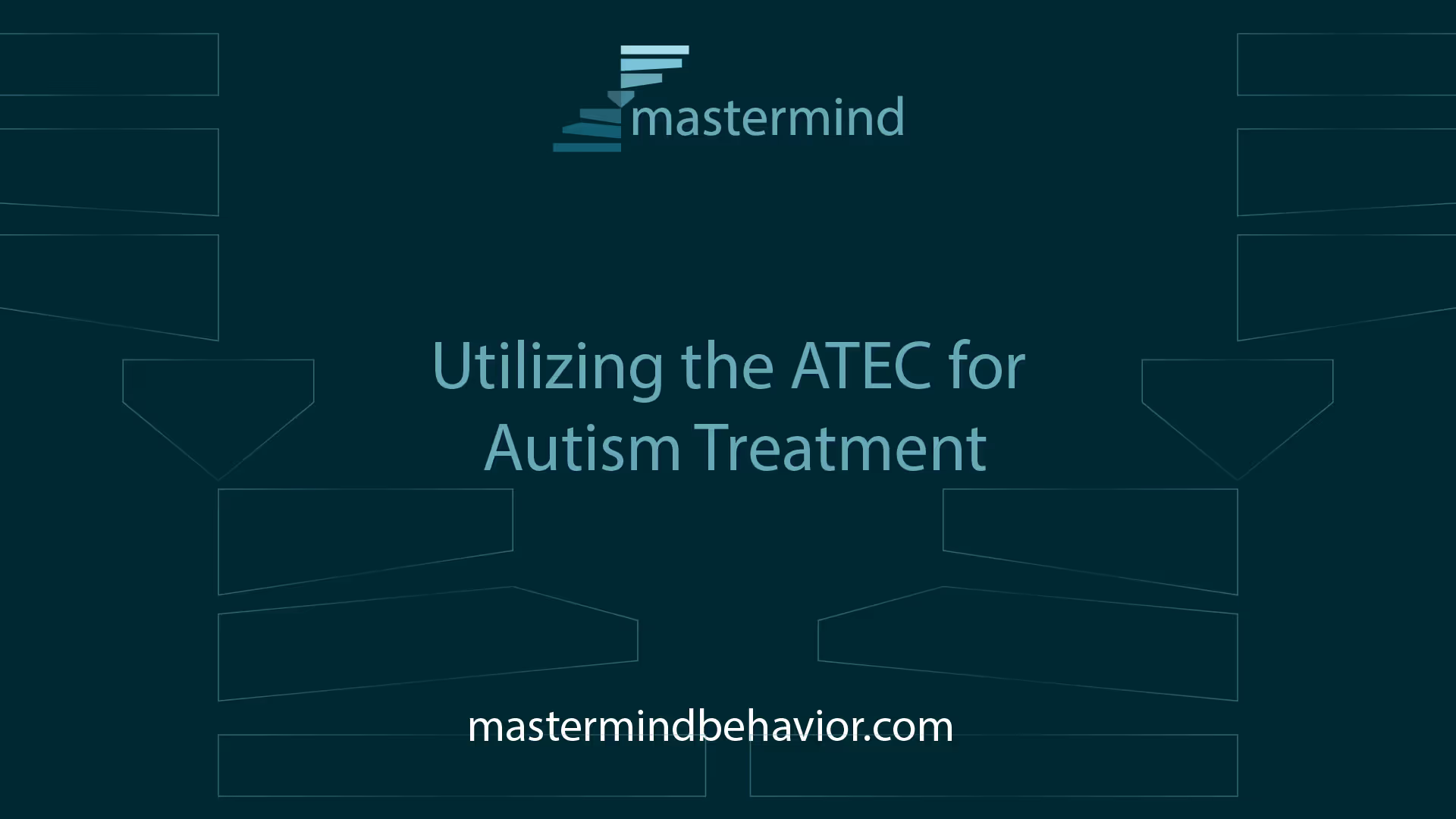Autism Treatment Evaluation Checklist

Understanding Counseling Interventions

Effective counseling interventions play a crucial role in autism care, helping clients work towards their goals, strengthen capabilities, identify opportunities, and modify behavior. This section delves into the purpose and types of counseling interventions, providing a clear understanding of their importance in the context of autism treatment.
Purpose of Counseling Interventions
The primary goal of counseling interventions is to assist individuals in transitioning from their current state to where they want to be. This involves:
- Helping clients work towards their goals
- Strengthening their abilities
- Identifying opportunities for growth
- Increasing motivation
- Modifying behavior
Counseling interventions are intentional behaviors or "change strategies" introduced by counselors to help clients manage problems and move towards their goals. This process requires a thorough assessment of the client's behavioral targets and needs to select the most appropriate intervention [1].
Types of Counseling Interventions
Counseling interventions encompass a broad range of techniques that can be tailored to fit the client's needs, values, and cultural context. Here are some common types of interventions:
- Cognitive Behavioral Therapy (CBT)
- Targets unhelpful, repetitive thinking patterns
- Aims to replace harmful thoughts, unrealistic expectations, or biased thinking
- Helps clients engage with change or negative emotions
- Behavioral Interventions
- Focuses on modifying specific behaviors
- Uses reinforcement techniques to encourage positive behavior
- Often used in Applied Behavior Analysis (ABA) for autism treatment
- Motivational Interviewing
- Enhances client's motivation to change
- Helps clients explore and resolve ambivalence
- Encourages clients to set and achieve personal goals
- Solution-Focused Brief Therapy (SFBT)
- Concentrates on finding solutions rather than focusing on problems
- Encourages clients to envision a positive future
- Helps clients develop actionable steps towards their goals
- Family Therapy
- Involves family members in the treatment process
- Aims to improve communication and relationships within the family
- Supports the family's role in the client's treatment and progress
These interventions can be performed individually or as part of a comprehensive treatment plan developed with the client. The selection of interventions is guided by the client's capability, opportunity, motivation, and behavior. Counselors need to have a diverse set of techniques at their disposal to create sufficient momentum for change and prevent clients from reverting to old patterns.
For more details on developing a comprehensive autism nursing care plan or understanding if level 2 autism can be cured, refer to our internal resources. Additionally, our family autism care team and autism services for adults in Arizona can provide further support and information.
Importance of Effective Interventions

Effective interventions are crucial in the realm of autism care, ensuring that individuals receive the support they need to thrive. This section explores the significance of a client-centered approach and the necessity of tailoring interventions to meet individual needs.
Client-Centered Approach
A client-centered approach in autism treatment places the individual's unique needs, preferences, and goals at the forefront. This method emphasizes the importance of understanding the individual's capabilities, opportunities, motivation, and behavior [1]. By focusing on the client, counselors can create a supportive environment that encourages progress and development.
In a client-centered approach, interventions are intentional behaviors or "change strategies" introduced by counselors to help clients implement problem management and move towards their goals. This requires a thorough assessment of the client's behavioral targets and needs to choose the most appropriate intervention [1]. By understanding each client's unique situation, counselors can better support them in achieving their objectives.
Tailoring Interventions to Individual Needs
Tailoring interventions to individual needs is essential for effective autism treatment. Each person with autism is unique, and their treatment should reflect their specific needs, values, and cultural background. The selection of interventions should be guided by a comprehensive assessment of the client's capabilities, opportunities, motivation, and behavior.
To ensure interventions are effective, counselors must document therapeutic interventions in progress notes. This documentation is crucial for monitoring a patient's progress, determining the efficacy of treatment plans, and deciding if different interventions are needed. It also serves as a record for insurance, compliance, and legal purposes.
Therapeutic interventions can be confrontational or collaborative, depending on the client's needs. These interventions aim to provide a positive effect on individuals experiencing distress, helping modify behaviors that interfere with their well-being and safety [2].
For more information on creating effective autism care plans, check out our article on autism nursing care plan. Additionally, for insights on autism treatment at different life stages, visit our page on autism services for adults in Arizona.
By adopting a client-centered approach and tailoring interventions to individual needs, counselors can provide more effective and personalized care. This ensures that each person with autism receives the support they need to reach their full potential.
Exploring the Autism Treatment Evaluation Checklist (ATEC)
The Autism Treatment Evaluation Checklist (ATEC) is a pivotal tool designed to measure the effectiveness of various treatments for autism. This section delves into the development and purpose of the ATEC, as well as its subscales.
Development and Purpose of ATEC
The ATEC was developed by Bernard Rimland and Stephen M. Edelson of the Autism Research Institute to address the need for a valid means of measuring the effectiveness of autism treatments. Prior to the ATEC, many studies produced inconclusive or misleading results due to a lack of useful tests or scales designed for this purpose.
The checklist is not intended to diagnose autism but rather to provide a means to track progress and evaluate the effectiveness of interventions. It is a self-reporting tool that can be completed by parents, teachers, or caretakers. The ATEC is designed for non-commercial use to monitor a child's development over time, making it a valuable resource for families, educators, and researchers [3].
Subscales of the ATEC
The ATEC consists of four subtests, each targeting specific areas of behavior and development. These subtests provide a comprehensive overview of an individual's progress in various domains.
The scores from these subtests are combined to provide a total score, which can range from 0 to 179. Lower scores indicate less severe symptoms of autism, while higher scores suggest more severe symptoms.
The ATEC is a practical tool for tracking improvements following interventions. By comparing baseline and post-treatment scores, caregivers and professionals can gauge the effectiveness of specific treatments. This makes the ATEC an invaluable component of an autism nursing care plan and other individualized care strategies.
For those interested in understanding how different assessments evolve, the ATEC represents a significant advancement over previous scales like the Childhood Autism Rating Scale (CARS) and the Gilliam Autism Rating Scale (GARS), which were primarily designed for diagnostic purposes rather than evaluating treatment efficacy [4].
Using the ATEC, parents, educators, and healthcare providers can make informed decisions about the best interventions to help children with autism thrive. For further reading on related topics, consider exploring family autism care team or can level 2 autism be cured.
Utilizing the ATEC for Autism Treatment

The Autism Treatment Evaluation Checklist (ATEC) is a valuable tool for assessing and tracking the progress of children with autism over time. This section will guide you through the process of completing the ATEC form and interpreting the scores.
Completing the ATEC Form
The ATEC is a self-reporting tool typically completed by caregivers, educators, or healthcare providers who are familiar with the individual being evaluated [3]. The checklist is divided into four subscales:
- Speech/Language/Communication
- Sociability
- Sensory/Cognitive Awareness
- Health/Physical/Behavior
Each subscale contains a series of questions about specific behaviors related to each domain. Respondents rate each behavior on a scale from 0 to 2:
- 0: Not a problem
- 1: Minor problem
- 2: Major problem
The responses are then summed to generate a score for each subscale and a total score ranging from 0 to 179, with lower scores indicating less severe symptoms of Autism Spectrum Disorder (ASD), and higher scores correlating with more severe symptoms.
Interpreting ATEC Scores
Interpreting ATEC scores involves understanding both the subscale scores and the total score. The scores provide insights into specific areas of behavior that may change over time. The Autism Research Institute provides cutoffs and interpretations for both subscale scores and total scores, which are used to calculate a percentile of severity relative to score distributions [6].
Changes in ATEC scores over time can indicate improvements or deteriorations in symptoms. For example, a study found that participants with an ATEC total score above 70 at the age of two years showed an exponential decrease in symptoms, reaching a constant baseline around the age of 12. Conversely, participants with a total score below 70 at age two showed an increase in ATEC total score after age 7, indicating a deterioration of symptoms in certain areas.
By regularly completing and interpreting the ATEC, caregivers and professionals can track the progress of individuals with autism and adjust treatment plans accordingly. For more information on creating an autism nursing care plan or understanding can level 2 autism be cured, explore the related articles on our site.
Understanding how to effectively use the ATEC can play a crucial role in providing in-home ABA services in New Jersey, ensuring that each child receives tailored and effective interventions to thrive in the real world.
Evaluating Treatment Efficacy
Evaluating the effectiveness of autism treatments is essential for ensuring that interventions are beneficial and tailored to individual needs. The Autism Treatment Evaluation Checklist (ATEC) is a valuable tool in this process, providing insights into a child's progress over time.
Role of ATEC in Tracking Progress
The ATEC allows parents, teachers, and researchers to assess the effectiveness of interventions by tracking changes in behavior over time. It is not a diagnostic tool but offers subscale scores and a total score that can be compared at different points in time.
A decrease in the total ATEC score indicates an improvement in symptoms, while an increase suggests a decline. This metric provides a clear and standardized way to measure behavioral changes, enabling caregivers and professionals to make data-driven decisions.
Comparing Baseline and Post-Treatment Scores
One of the most significant advantages of the ATEC is its ability to compare baseline and post-treatment scores, offering a comprehensive view of an individual's progress. This comparison helps in understanding the long-term impact of interventions.
Participants with an initial ATEC score above 70 at the age of two showed an exponential decrease in symptoms, reaching a constant baseline around the age of 12. Conversely, those with an initial score below 70 at age two experienced a deterioration of symptoms after age seven, particularly in the Communication, Sociability, and Sensory subscales.
By continuously tracking and comparing ATEC scores, caregivers and professionals can adjust treatment plans to better meet the needs of the individual. This ensures that interventions remain effective and are tailored to promote the best possible outcomes.
For more information on creating an autism nursing care plan or understanding family autism care team dynamics, please visit our related articles.
Advancements in Autism Treatment Evaluation
Evolution of Assessment Tools
The Autism Treatment Evaluation Checklist (ATEC) was developed to address the limitations of existing scales like the Childhood Autism Rating Scale (CARS), the Gilliam Autism Rating Scale (GARS), and the Autism Behavior Checklist (ABC). These tools were primarily designed for diagnosing autism rather than evaluating treatment effectiveness [4].
The ATEC, copyrighted by Stephen M. Edelson, PhD, and Bernard Rimland, PhD, provides a standardized and reliable means to monitor and document changes in a child's behavior over time. Unlike its predecessors, the ATEC is specifically intended for non-commercial use by parents, teachers, and caretakers, as well as researchers assessing intervention effectiveness.
The ATEC’s development marks a significant progression in autism care, offering a more comprehensive and user-friendly tool for tracking treatment outcomes across various age groups. This has made it an invaluable resource in the ongoing improvement of autism interventions.
Future Implications of ATEC Usage
The Autism Treatment Evaluation Checklist has proven to be a valuable tool in the evaluation of autism treatments. It provides cutoffs and interpretations for both subscale scores and total scores, which can be used to calculate a percentile of severity relative to score distributions provided by the Autism Research Institute [6]. This allows for a more nuanced understanding of a child's progress and the effectiveness of specific interventions.
Research has aimed to generate developmental norms for the ATEC to be used as an outcome measure for longitudinal assessment of individuals with autism spectrum disorder (ASD). These norms can be utilized by parents, therapists, and researchers to compare a child's development to a large group of individuals with the same diagnosis.
The future implications of ATEC usage are promising, particularly in enhancing personalized approaches to autism treatment. By providing a detailed and structured method for evaluating progress, the ATEC supports a client-centered approach, ensuring that interventions are tailored to the individual needs of each child. This aligns with the broader goals of autism care, such as those outlined in our autism nursing care plan and the work of the family autism care team.
As the ATEC continues to evolve, it is expected to play a pivotal role in the future of autism treatment evaluation. By offering a reliable and accessible means to monitor treatment efficacy, the ATEC not only aids in the immediate care of individuals with autism but also contributes to the long-term improvement of autism interventions. For more insights on autism care and treatment, visit our resources on can level 2 autism be cured and autism services for adults in Arizona.
References
[1]: https://positivepsychology.com/counseling-interventions/
[2]: https://www.icanotes.com/2023/04/28/therapeutic-interventions-for-progress-notes/
[3]: https://www.myteamaba.com/resources/autism-treatment-evaluation-checklist
[4]: https://autism.org/autism-treatment-evaluation-checklist/
[5]: https://www.ncbi.nlm.nih.gov/pmc/articles/PMC5835994/
[6]: https://en.wikipedia.org/wiki/AutismTreatmentEvaluation_Checklist
Recent articles

Developing a Routine for Children with ASD to Promote Functional Skills
Creating Predictable Daily Structures for Autism Support

The Benefits of Structured Recreational Activities for Children with Autism
Enhancing Development and Well-Being Through Organized Play

How to Manage Transitions Between Therapy Programs for Children with Autism
Ensuring Smooth Transitions in Autism Therapy Programs

How to Encourage Positive Interactions Between Siblings in Autism
Building Bridges: Fostering Harmonious Sibling Relationships in Autism

The Connection Between Emotional Regulation and Academic Success in Autism
Enhancing Learning Outcomes: The Vital Role of Emotional Regulation in Autism

The Importance of Teaching Self-Regulation Strategies in ASD
Empowering Children with ASD through Self-Regulation Skills


